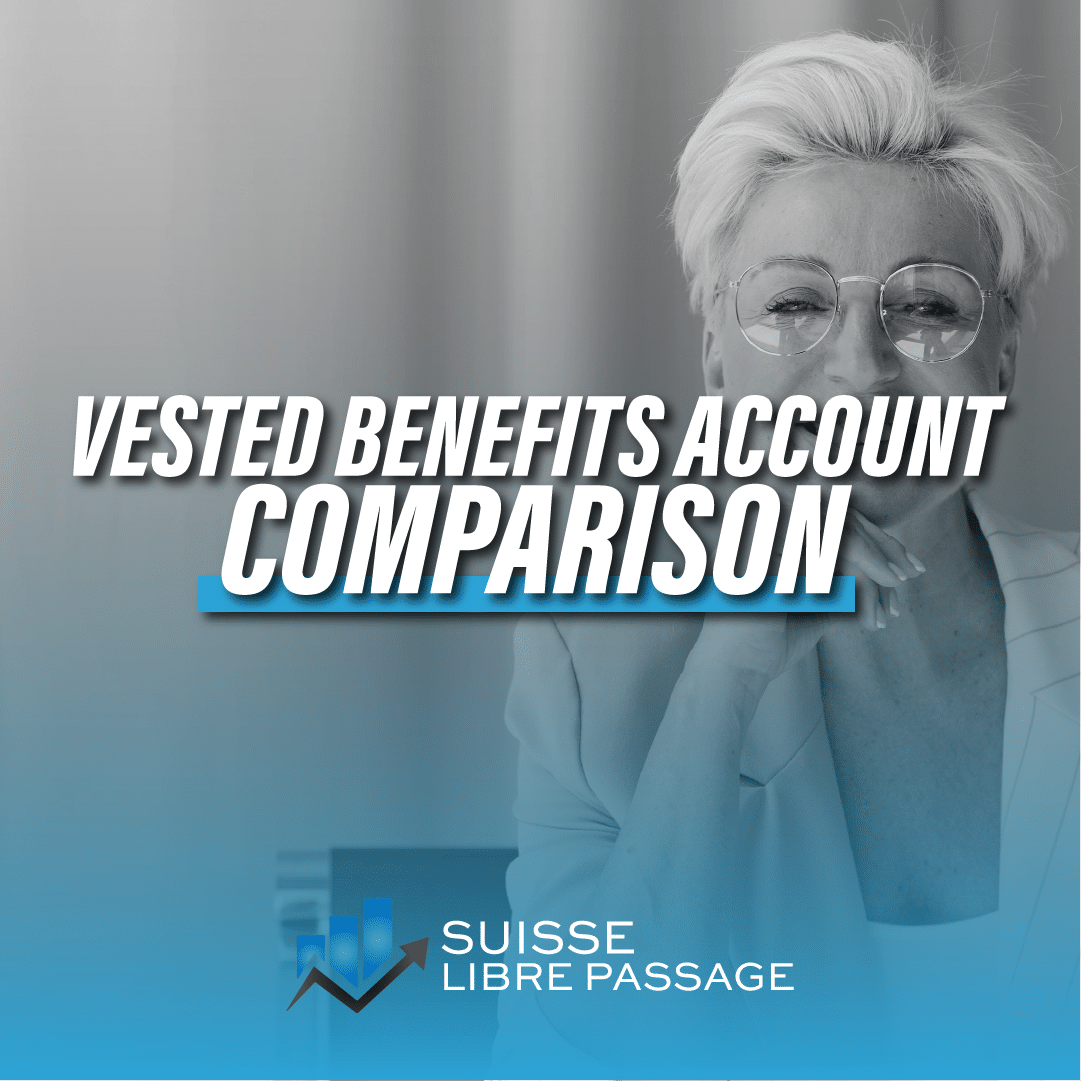LEAVING SWITZERLAND: VESTED BENEFITS AND 2ND PILLAR

SOMMAIRE :
SHARE THIS ARTICLE :
I’m going to leave Switzerland, what should I do with my Swiss 2nd Pillar (LPP)?
It has been mentioned several times in many articles about the second pillar that the Swiss occupational pension plan (LPP) is an integral part of the Swiss social security system and will fill in the gaps of the 1st pillar AVS at your retirement.
Many questions arise concerning this 2nd pillar, from LPP contributions to the critical question of what happens to the Swiss LPP when leaving Switzerland.
Various reasons can lead employees to leave Switzerland. Of course, this change typically raises the same question: what about the occupational pension plan LPP?
Should one be concerned about the conditions for withdrawing retirement assets? How can taxes on LPP assets be minimized? The payment of the 2nd pillar through a vested benefits account depends on the agreement between Switzerland and the new target country: it’s not your nationality that determines the nature of the payment, but the law of your new country of residence.
Therefore, it’s essential to clarify the points of friction related to the payment of LPP assets or savings in vested benefits accounts.
TAXES AND SWISS 2ND PILLAR (LPP):
Upon withdrawal of the 2nd pillar vested benefits, the amount is subject to tax on vested benefits assets (this tax is calculated separately from income tax).
If your new country of residence does not have any agreement or if its agreement does not account for the 2nd pillar vested benefits, then the tax to be paid will be collected by the Foundation in Switzerland. This will be based on the tax scale of your canton, which can vary significantly depending on location. As legislation varies by canton, there’s a potential for optimization.
Because what’s crucial to understand is that upon leaving Switzerland, it’s the vested benefits foundation that will collect the tax and remit it to your canton. This tax amount isn’t determined by the applicant’s last place of residence but rather by the location of the headquarters of the last pension fund or vested benefits foundation where the assets were entrusted.
For example, the Canton of Schwyz offers a very low withholding tax compared to other Swiss cantons. Consequently, an increasing number of residents wishing to leave Switzerland entrust their pension assets to an institution located in the Canton of Schwyz. Given this, and considering the legislation, several pension institutions have chosen to establish themselves in Schwyz. In this array of choices, it’s important to meticulously review the various offers provided by these institutions.
Leaving Switzerland and extra mandatory part from Swiss 2nd Pillar Pension (LPP):
Indeed, when leaving Switzerland, it’s important to consider your Swiss 2nd Pillar Pension (LPP), especially the mandatory and the extra mandatory parts.
- It’s important to note that if you’re leaving Switzerland for a non-European Union country, you have no issues and can withdraw your entire 2nd pillar without any concerns.
- If you’re withdrawing your 2nd pillar to leave Switzerland for a European Union member state, you can only withdraw the extra mandatory part, leaving the mandatory part in Switzerland until retirement.
To determine the amount of your extra mandatory part when departing for a European Union country, you can contact us. If you’re interested in a comparison of vested benefits accounts for your mandatory part, feel free to fill out the form at the end of the article.
Swiss 2nd Pillar Pension (LPP): Double Taxation Agreement
In cases where legislation permits you to withdraw your LPP assets, the consideration of the Swiss 2nd pillar LPP by your new country of residence will determine the degree of taxation on your assets. This taxation can naturally be imposed by the new country of residence. In this case, Swiss taxation will refund you the entirety of the tax withheld (at the source).
Switzerland has indeed established over 80 double taxation agreements with various countries worldwide, some of which account for LPP payments. This allows for the reimbursement of LPP tax paid at the Swiss source. Consequently, your LPP assets are impacted by the amount of taxation in the new country of residence, which is typically higher. This specific double taxation legislation concerning the 2nd pillar LPP raises logical questions regarding the withdrawal of the 2nd pillar.
Would you like to learn more about LPP contributions and how to optimize your capital in the 2nd pillar or your vested benefits account?
This form will directly connect you with a LPP professional.
How to invest your Swiss 2nd Pillar Pension (LPP) before leaving Switzerland?
If your situation doesn’t allow you to withdraw your LPP assets, you will also need to transfer the funds to a vested benefits account.
Your pension fund will specifically request details of your account. You’ll have the opportunity to conduct a comparison of vested benefits accounts. In this process, several variables need to be carefully considered:
- Amount of LPP Capital: Based on the amount involved, it’s recommended to open a single account instead of two to optimize your assets as much as possible.
- LPP Interest Rate: The conditions here depend on the payment amount, so it should be clearly defined with your funds beforehand. This allows you to use the proposed interest rate to compare different offers.
- Location of the Accumulated Interest Account: The canton where your Swiss LPP is located matters. As previously mentioned, depending on your residence canton, destination country, these factors become important when leaving Switzerland and your LPP.
As mentioned above, taxes are based on the laws related to the state of your accumulated interest account, making precise research very important.
Leaving Switzerland, Swiss 2nd Pillar Pension (LPP) as a Cross-Border worker:
There are no less than 100,000 cross-border workers in French-speaking Switzerland in 2021.
They are an integral part of Switzerland’s workforce, and just like every Swiss worker, they contribute to the 2nd Pillar Pension (LPP).
So, what are the implications for a cross-border worker if they leave Switzerland and want to withdraw their 2nd pillar?
In reality, the conditions for withdrawing the 2nd pillar for a cross-border worker are exactly the same:
- If they leave Switzerland for France, they can only retrieve the extra mandatory part before retirement.
- If a cross-border worker leaves Switzerland for a non-European Union country, they can withdraw the entire LPP (2nd pillar in Switzerland).
Leaving Switzerland, Swiss 2nd Pillar Pension (LPP), and Retirement:
When one decides to leave Switzerland, they often consider withdrawing their 2nd pillar LPP, but is this really the right solution?
It’s important to compare vested benefits accounts, as the LPP contributions accumulated during your career could allow you to have a more comfortable retirement by leaving this 2nd pillar in Switzerland:
- Swiss vested benefits foundations are highly regulated in the legal domain.
- Returns of 3 to 5% depending on investment strategies.
- Attractive taxation until the withdrawal of 2nd pillar assets.
- Opportunities for optimizing taxes on the withdrawal of 2nd pillar assets.
To receive assistance with the procedures for leaving Switzerland regarding the 2nd pillar, don’t hesitate to fill out the form below. An expert in the 2nd pillar will contact you within 24 hours.
MY FREE VESTED BENEFITS ACCOUNTS COMPARISON!








